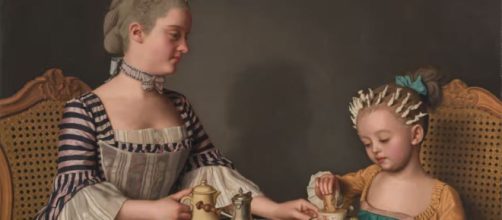You can pick up a lot of world history by reading art history. In practical terms, you don’t even have to read anything. Just look at the pictures of art through the ages and the past will come into view.
Of course, not all artwork is a good teacher about the time it was made. Consider Jean-Etienne Liotard’s painting “The Lavergne Family Breakfast” now featured at the National Gallery in London.
Liotard lived in the 18th century, the Age of Enlightenment that upheld ideals like the pursuit of learning, logic, and constitutional government.
Watch your manners!
But you won’t find any of that in this featured work. Which may accounts for why the National Gallery doesn’t mention the Age of Enlightenment in its website discussion of this painting.
Liotard pictured a high-society woman showing her little daughter how to dip a biscuit in milk without making a mess.
This certainly wasn’t as high-minded as, say, “Oath of the Horatio,” a painting about patriotism and bravery by fellow Age of Enlightenment artist Jacques-Louis David. Liotard’s fellow artists noticed the difference.
"The only merit in Liotard’s pictures is neatness," said Sir Joshua Reynolds, “which, as a general rule, is the characteristic of low genius, or rather to no genius at all.”
Look who’s talking!
But Reynolds wasn't always high-minded in his work.
His “Portrait of Charles Coote, Earl of Bellamont” shown in robes of the Order of the Bath, is positively glorifying – almost to the point of silliness.
Beside patriotism and bravery, the Age of Enlightenment also came with the quiet, simple neoclassical style of Old Rome and Greece. Likely, these aspects were meant to escape the emotionalism of Baroque and over-decoration of Rococo styles that came before.
Maybe it was the unearthing of Pompeii in the middle of the eighteenth century, or the French Revolution that de-popularized Baroque and Rococo. Certainly, it had been a while since art took its cue from classical antiquity.
All of which points to the end of frivolity and sob-stuff and the return to order, simplicity, even austerity in art.
And in that particular sense, Liotard fits the billing. Despite the elegant gowns of mother and daughter, “The Lavergne Family Breakfast” is, if nothing else, a vision of simplicity.
Hold on. Jonathan Jones, art critic for The Guardian, sees more Age of Enlightenment in Liotard’s breakfast scene than I do. He sees it as “this 18th-century ideology (that) valued reason, sociability and manners.”
Putting on airs
Still, I can’t help thinking of the affectations that Liotard took on, like growing a long beard, adopting Turkish dress, and nicknaming himself “the Turkish painter.”
Another Liotard affectation can be seen in his “Self-Portrait with Beard.” There, you see him in a bright red velvet jacket standing at his easel.
The coup de grâce is an upheld pinky finger.
For all that, though, Neoclassicism’s signature seeps into Liotard’s portrait Marie-Adelaide, third daughter of Louis XV.
Aside from the child in Turkish garb, the painting is devoid of detail. And hey, sign of the times – the Age of Enlightenment – she’s reading a book!


